Summary:
"An overweight dog is subject to the same problems as overweight people - heart trouble, diabetes, arthritis, and a host of other health problems. And obesity is common in pets. A recent study found that as many as 40% of all American pets are overweight. Unfortunately, canine obesity is the #1 nutrition-related dog health problem with half of all dogs in the United States being overweight, which means that their body weight is more than 15% higher than optimal. More than 25% of dogs are considered obese, which means that the adult body weight is greater than 30% or greater than the ideal weight for their breed, size, and age.
A large study of dogs in the United Kingdom and the United States reinforces that avoiding obesity and proper nutrition is important for a dog's health. The study found that dos with very rapid weight gain tended to be overweight or even obese by 3 years of age. These dogs were at higher risk of orthopedic problems associated with weight such as osteochondritis dessicans, hip dysplasia, and elbow dysplasia. Almost all dogs were on a balanced diet, indicating that the weight gain was due to over nutrition (being given too much food.)
Obesity is the 4th leading cause of death among dogs in the United States (AVMA) making pet obesity prevention a priority for pet parents. Signs of obesity include reluctance to exercise such as less play and physical signs such as no longer being able to feel your dog's ribs and the accumulation of fat at the tail and abdomen. Related health problems are osteoarthritis and hip dysplasia. Owners that tend to indulge their dogs at home, such as allowing them to lie on their bed, tend to overfeed their dogs.
Simply put, your dog gains weight when he eats more calories than he burns. If he is overweight, he needs to eat less and exercise more. Here are some tips for helping your dog make the transformation to good health. Weigh your dog every month and keep track. A reasonable weight-loss plan goal in dogs to reach the ideal body weight is 3% to 5% per month until you reach the dog's weight loss goals. A small weight loss plan will enable your dog to reach its goals gradually."
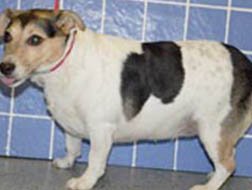
Overview: How to Help Your Overweight Dog
Obesity is a leading health problem in dogs. It can trigger and worsen several medical conditions such as osteoarthritis, diabetes, and cardiovascular problems.
Risk factors for obesity include:
- Older Age (11 and above)
- Presence of diseases that increase body weight or decreased activity levels
- Underestimation of a dog's body condition by the owner (44% of owners underestimate their dog's body condition score - BCS)
Certain Breeds with a higher propensity for weight problems:
Large Dog Breeds
- Collie
- Golden retrievers
- Rottweiler-- Labrador Retriever (typically weigh 65 to 80 pounds)
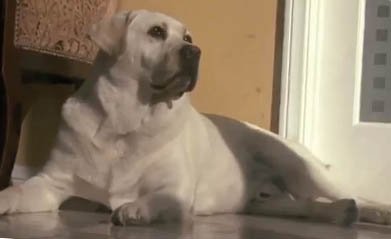
Giant
- -Burmese Mountain Dog
- -Newfoundland
- -Saint Bernard
Medium
- Beagle
- -Cocker Spaniel
- -Basset Hound
Small
- Cairn Terrier
- Dachshund
- Cavalier King Charles
- Scottish Terrier
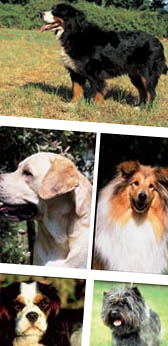
Causes of Weight Gain in Dogs
There are multiple causes of dog weight gain including:
- Thyroid deficiency
- Endocrine disease: which slows the rate at which food is metabolized
- Diet: eating more calories than a dog burns in a day
- Genetics
- Age
- Puppies: between age 9 and 12 months
- Adults: 40% of all dogs (lower on the younger end of the spectrum)
- Sex: more females than males
- Neutering: Obesity is 2x as frequent in neutered females, and higher in all neutered dogs (32% of dogs)
- Contraceptive Treatments: dogs treated with medroxyprogesterone acetate had significant weight gain
- Lack of exercise
- Poor food selection
- Social Aspects of Eating: the relationship between dog and human plays a role. Owners of obese dogs talk to their dogs more and allow the dog to lie on their beds. These dogs are given more meals or treats than dogs that have normal body weights.
- Dog Size: The size of the dog plays a role in the obesity guidelines. A Chihuahua is overweight when 1 to 2 pounds over normal. A large Irish wolf-hound is obese when it is 60 pounds overweight. Keeping your dog at normal weight can extend his or her life and improve your dog's quality of life.
- Lifestyle and Exercise: A dog's lifestyle can also contribute to obesity with many small indoor dogs not going outside enough resulting in a lack of exercise.
Obesity Symptoms
Beyond the weight gain itself, one of the signs of dog obesity is changes in behavior. If pet parents observe that a dog is not as active as in the past, such as reluctance to play or go on a hike, then the problem might be obesity. Other signs are reluctance to climb stairs or to leap out or into your car.
Dog Weight Guideline (How to Tell If Your Dog Is Overweight)
As a guideline, check your dog's body composition. if you can feel your dog's ribs with the flat of your hand, but can't see them, then your dog is probably near its optimal weight. If you have to push through a thin layer of fat with the flat of your hand to feel your dog's ribs, then your pet is probably overweight. This is true in adult dogs and puppies.
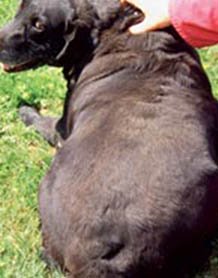
The dog should also have an hourglass shape when the hips, waist, and chest are viewed from above. Other physical signs include:
- Fat at the tail base
- Fat over the hips
- Waddling gait
- A growing potbelly appears as if the normal "tuck" of the abdomen is no longer visible
A veterinarian will measure weight and body condition on a 5 point scale where 3 or more is considered to be obese.
The daily calorie intake for each dog breed will vary based on the amount of energy they expend. Once you understand this level, then losing weight is a function of gradually cutting back on calories and increasing exercise. You can also check the American Animal Hospital Association (AAHA) Nutrition and Weight Management Guidelines.
Breed Weight Chart
The American Kennel Club offers a breed weight chart that provides a range of a dog's ideal weight.
Health Problems Related to Obesity in Dogs
Being overweight can aggravate several dog health problems. These include:
- Osteoarthritis: when the cartilage wears away and the bone comes in contact with other bone. The result is pain and inflammation in the joint. Heavier dogs put more strain on the joints, making them unstable.
- Hip Dysplasia: An inherited condition that results in malformation of the hip socket. It prevents a proper fit between the ball at the top of the thigh bone and the bone itself. Being proper weight reduces pressure on the joint.
- Diabetes: When a dog takes in too many carbohydrates, the body stimulates insulin-producing cells in the pancreas. Excessive insulin can result in the body being less sensitive to insulin and burnout of the insulin-producing cells.
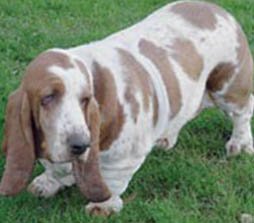
- Heart Health: Overweight dogs put strain on a heart that has to pump blood through excess vessels and tissue.
- Reduced Longevity
- Reduced Immunity
- Mammary Tumors
Diagnosis
Talk to your vet to find out the ideal weight for your dog and whether your dog is overweight. Before beginning a dog weight loss program, your vet should do blood work to make sure your dog does not have any medical issues that result in weight gain - such as a thyroid problem that might be causing the weight problem. If your pet’s thyroid gland is functioning properly and your pet is otherwise healthy, then it is time to begin overweight dog treatment.
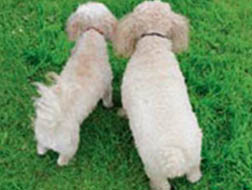
Overweight Dog: Food, Diet and Weight Loss Tips
Over-weight canine treatment is relatively simple. Feed your dog high-quality dog food with a level of caloric intake that matches the energy expenditure of your dog.
Many vets recommend against “diet” or low-calorie dog foods because these are high in carbohydrates, which can actually cause your dog to gain weight. Others recommend a meat-based diet. Your veterinarian can best determine if a "low calorie" dog diet is appropriate.
In addition to dietary changes, veterinarians have access to medications and even fasting in the office to encourage weight loss.
Surgical techniques (like those used in humans) are not available for dogs.
Portion Size
In general, veterinarians do not recommend that portion size be
reduced. Preference is for improving the diet by reducing fat content
and by increasing dietary fiber. Reducing portions may result in
deficiencies in nutrients and changes in behavior from a dog that is
reacting to having less food (food theft, nervousness, unpleasant
behavior). Yes food selection can be complicated, which is why
purchasing a quality food is essential that is done in consultation
with your veterinarian.
To start your overweight dog treatment, weigh your dog. Then, change or reduce the amount of food you give your dog by about 20% (if you decide to go this route). Greater levels of reduction may be needed in dogs that are gaining weight (make it 30%). Make sure to include treats or snacks you give your dog in the total amount of food given. Make sure your dog has access to fresh water at all times.
After two weeks, weigh your dog again. If your dog has lost even a little weight, you are on the right track. Stick with this schedule. If there has been no weight loss, reduce your dog’s food intake by one-third again.
You can also help your dog lose weight by providing opportunities
for
exercise. Taking your dog for a walk or a run will be good for both of
you.
Weight Loss Foods
Pet owners can start with a commercial control diet designed to reduce calorie intake. Every major brand offers a specialized product to help an overweight dog lose weight. These products are specifically manufactured for overweight and obese dogs. Products offer lower calories to reduce the dog's daily calorie intake and meet the AAFCO standard for an adult maintenance diet. One benefit is that you can often keep your dog at the same food volume as they consume fewer calories while improving the level of nutrients.
Portion Size and Accurate Measurement
In general, veterinarians do not recommend that portion size be reduced. Preference is for improving the diet by reducing fat content and by increasing dietary fiber vs. portion control. Reducing portions may result in deficiencies in nutrients and changes in behavior from a dog that is reacting to having less food (food theft, nervousness, unpleasant behavior). Yes, food selection can be complicated, which is why purchasing quality food is essential that is done in consultation with your veterinarian.
To start your overweight dog treatment, weigh your dog. Then, change or reduce the amount of food you give your dog by about 10% to 20% (if you decide to go this route). Greater levels of reduction may be needed in dogs that are gaining weight (make it 30%). Make sure to include treats or snacks you give your dog in the total amount of food given. Make sure your dog has access to fresh water at all times.
After two weeks, weigh your dog again. If your dog has lost even a little weight, you are on the right track. Stick with this schedule. If there has been no weight loss, reduce your dog’s food intake by one-third again.
Use a measuring cup when portioning out the food. Do not "heap" the amount in the cup.
Limit Treats
For some overweight or obese dogs, the problem might be too many snacks or treats. Snacks are often calorie-dense foods that can impact a dog's diet. One idea is that instead of providing food as a meal, you can portion it out as a series of treats.
Home-prepared Diets
The research is not clear that home-prepared or commercial diets are better for an obese dog. If you do feed a homemade diet for obesity, select lean meat, a high-fiber source of starch, vegetables, and dietary fiber supplements that are in a purified form (soy fiber, bran).
You can add water and vegetables to your dog's meals to help them feel more full. Add vegetables such as green beans to the kibble along with water. Hydration reduces the feeling of hunger. Another tip is to provide a teaspoon or tablespoon of pumpkin depending on your dog's size.
Supplements and Weight Loss
Some owners add an herbal supplement to the diet that contains ingredients such as Milk Thistle and Dandelion to help dogs digest food more efficiently and boost their metabolism such as the product SlenderPet Formula. While there are many positive user reviews of these products, the science is not as clear. See the manufacturer's website for studies and information.
One product that is approved for canine weight loss by the U.S. Food and Drug Administration is Slentrol. It is provided by mouth and works via two mechanisms in the small intestine. It is the first approved medication to keep fat from being absorbed and to decrease dog appetites. It should only be used under the care of a veterinarian.
Research shows that dogs fed a low-calorie diet can benefit from ingredients that contain L-carnitine, an ingredient that helps prevent a weight rebound effect. This ingredient stimulates muscle mass and increases weight loss (Sunvold et al., 1998).
Exercise
While obvious, more exercise and long walks can help. Consider increasing the time spent walking by 10% per week, or walk faster. Other options are to play ball. Do not push your dog beyond its capability. When exercising slowly build up the length and intensity of each session.
Rate of Weight Loss
Slow weight loss should be the goal and not exceed 1% of the dog's beginning body weight per week (1 pound a week for a dog that is 100 pounds in weight).
Weigh your dog again in two weeks. You should be seeing results by this time, but if not, continue this procedure until you do. If you are not seeing results, it may be that someone in the house is feeling sorry for the dieting dog and sneaking him some snacks. Make sure you have everyone’s cooperation in helping your dog achieve a healthy weight.
It can take 6 to 9 months to achieve the normal weight.
Dog Food Myths
Research shows that dividing the diet into several daily meals does not contribute to an increase in obesity. There is also not an influence of wet or dry dog food in the frequency of obesity.
Free Brochures on Weight Loss in Dogs (PDF)
Available in Ebook
Available in Ebook
Ask Our Vet A Question or Share Your Story
Have A Question about Dog Weight Loss or Obesity?
Do you have a question or comment? Share it!
Our editors will pick 1 question to answer each week. Please include your dog's age, breed, current diet, medical history and medications and if possible, a picture of your dog.
We will do our best to get back to you quickly (it depends on how many questions we receive each day). If you do require an immediate response we suggest using this online dog veterinary service that is available now.
Other Reader Dog Weight Related Questions and Vet Suggestions
Click below to see contributions from other visitors to this page...
Pittbull Diet for Weight Loss Not rated yet
I recently took my Pitbull to the Vet who treated water on the lung and heart. She is fourteen and cannot do steps. I am worried that I might have to put …
References
Obesity: Epidemiology, Pathophysiology and Management of the Obese Dog
Authors: M. Diez and P. Nguyen
Department of Animal Productions
FAculty of Veterinary Medicine
University of Liege
Project Slim Down
American Animal Hospital Association
Prevalence of overweight and obesity and associated risk factors in dogs in the Netherlands
Author(s): Blees N.R., In: EVC - Voorjaarsdagen - The Hague, 2017 by European Veterinary Conference - Voorjaarsdagen
Updated: JUL 05, 2017
